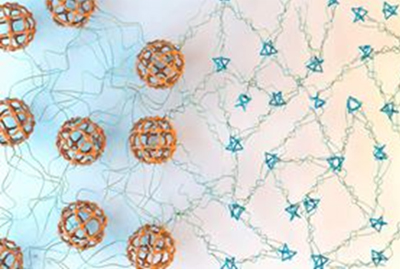HC Plastics News:
Researchers at the Massachusetts Institute of Technology (MIT) have designed a polymer material that changes its structure to respond to light, transforming it from a hard substance into a flexible substance that can heal itself when damaged.

The picture shows a polymer designed by a chemist at the Massachusetts Institute of Technology that is both light-sensitive and reversibly switchable from a large structure (orange sphere) to a smaller blue object.
Jeremiah Johnson, an associate professor of chemistry at the Massachusetts Institute of Technology, is a member of the MIT's Koch Institute for Integrative Cancer Research and the leader of the Polymer and Soft Matter Project Research Group. He said: "You can switch the state of the material back and forth, and in each state, even if it consists of the same composition, it is like a completely different material."
According to Johnson, this material consists of a polymer attached to a photoreceptor that can be used to change the chemical bonds formed inside the material. Although this material can be used to coat objects such as cars or satellites, allowing them to heal after damage, these applications are far away in the future.
The first author of this paper published in the journal Nature is Yuwei Gu, a graduate student at the Massachusetts Institute of Technology. Other authors include Eric Alt, a graduate student at the Massachusetts Institute of Technology, Adam Willard, an assistant professor of chemistry at the Massachusetts Institute of Technology, and Heng Wang and Xiaopeng Li at the University of South Florida.
Many of the properties of a polymer, such as its hardness and expansion capacity, are governed by its topology, which is related to how the composition of the material is aligned. Often, once a material is formed, its topology cannot be reversibly altered. For example, the rubber ball remains elastic and does not become brittle without changing its chemical composition.
In this paper, Johnson and his colleagues want to create a material that has never been seen before, and it can be reversibly switched between two different topological states. They realized that they had designed a polymer metal organic cage material polyMOCs a few years ago, which is a promising candidate for its realization. Poly MOCs form a cage structure by joining metals through a flexible polymer.
Researchers make these materials by mixing polymers attached to a group called a ligand that can bind to metal atoms. Each metal atom (typically metallic palladium in this case) can be bonded to four ligand molecules to form a rigid cage cluster having a different ratio of palladium to ligand molecules. These ratios determine the size of the cage cluster.
In this new study, the researchers plan to design a material that can be reversibly switched between two cages of different sizes: one with 24 palladium atoms and 48 ligands, one with 3 palladium atoms and 6 One ligand molecule.
To achieve this goal, they incorporated a photoactive molecule called DTE into the ligand. The size of the cage is determined by the angle of the bond between the nitrogen molecules on the ligand and palladium. When the DTE is exposed to ultraviolet light, it forms a ring in the ligand, which increases the angle at which the nitrogen bonds to the palladium. This causes the cluster to rupture and form larger clusters.
When the researchers glowed green on the material, the ring was broken and the bond angles became smaller, re-forming smaller clusters. The process took about five hours to complete, and the researchers found that they could make seven reversals. At each reversal, there is always a small fraction of the polymer that cannot be reversed, eventually leading to material separation.
When the material is in a small cluster state, it is 10 times more dynamic and more dynamic than a flexible material under normal conditions. Johnson said: "They can flow when heated, which means you can cut them and heal themselves under mild heating conditions."
This approach overcomes the problem that typically occurs with self-healing materials, that is, they tend to be relatively weak in structure. In this case, the material can be switched between a softer self-healing state and a more rigid state.
In this study, the researchers used polymer polyethylene glycol (PEG) to make materials that they believe could be used with any kind of polymer. Potential applications include self-healing materials, and although this method is widely used, the rare and expensive metal of palladium must be replaced by a cheaper alternative.
"Anything made of plastic or rubber can be repaired if it is damaged," Johnson said. "You don't have to throw it away. Maybe this method will give the material a longer life."
Another possible application of these materials is drug delivery. Johnson believes it is possible to encapsulate the drug in a larger cage structure and then expose them to green light to open and release. The application of green light also allows the drug to be recaptured, providing a new approach to reversible drug delivery.
Researchers are also working to create materials that reversibly transform from solid to liquid, and use light to create a flexible and rigid pattern within the same material. 
Editor in charge: Yao Chunlin
The Drainage products can be divide to more kinds according the application, It can be divide to Drainage Mat,Draining Board,Drainage Composite,Drainage Panels,retaining wall drainage,geonet drainage,drain net,foundation drainage,dimple board.
Application: Highway,Railway,The garage roof greening,roof garden,golf course project,landfill projects ect.
Drainage Composite
Drainage Mat,Draining Board,Drainage Composite,Drainage Panels
HUATAO GROUP LTD , https://www.huataogroup.com